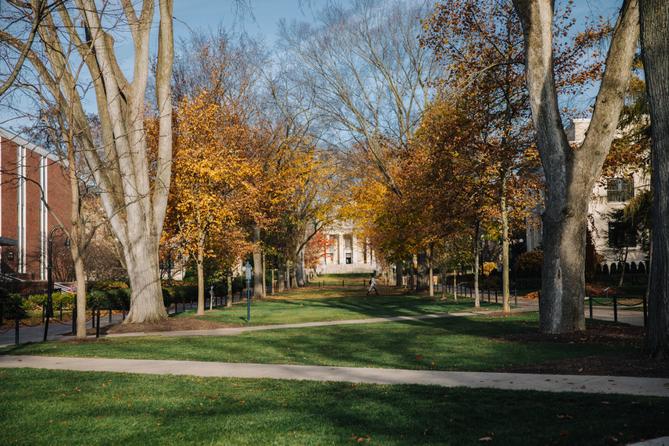This story first appeared in The Investigator, a weekly newsletter by Spotlight PA featuring the best investigative and accountability journalism from across Pennsylvania. Sign up for free here.
STATE COLLEGE — A group of faculty in Penn State’s Department of English allege that they are not paid a living wage, and that they are the lowest-paid teaching unit at the university.
The group comprises faculty who do not have tenure — a permanent appointment to the school staff — and who are not eligible for it. At Penn State, these non-tenure-line employees are called teaching faculty.
Salary data collected by faculty in the department, and shared with Spotlight PA, suggest lecturers are annually paid around $35,000, assistant teaching professors earn about $38,500, and associate teaching professors make around $42,500.
The living wage for a single adult without children in State College is $37,545, according to The Massachusetts Institute of Technology. For a single adult with a child, the needed annual income jumps to $70,989.
“What you’re looking at is a university actively hacking its own legs off by exploiting its own workers,” Brendan Prawdzik, an assistant teaching professor, told Spotlight PA.
Prawdzik, who has Type 1 diabetes, took out a small loan in early 2022 to cover medical expenses, he said. Then, in January, prices of two of his prescriptions totaled about $340, but he said he could only afford one at the time and spread the cost across two paychecks.
Prawdzik — and four other faculty members interviewed by Spotlight PA — pointed out that nearly all Penn State students are required to take two English courses, which are mostly taught by teaching faculty.
Wyatt DuBois, director of university public relations, said in an email the university has worked for years to “address salary inequities in the department.”
“The College of the Liberal Arts and the provost are actively working together to find a solution that aligns with the financial goals of the university while addressing concerns about the compensation levels of non-tenure-line faculty in the Department of English,” DuBois said.
As part of the university’s two-phase salary adjustment plan, Penn State raised salaries for English teaching faculty at each rank by $3,000 in January 2022, according to faculty.
However, Penn State scrapped the second phase, merit-based raises, because of “financial challenges facing the university,” DuBois said.
The English faculty’s claims that the department is the lowest paid at the university, and the salary information they provided, are difficult to verify.
Penn State declined to provide salary ranges, or average salaries, for teaching faculty at the various ranks within the English department. Spotlight PA then shared the salary data faculty provided to offer the university a chance to comment or clarify. The university declined.
“We have nothing further to add,” DuBois said in an email.
Internal Penn State data shared with Spotlight PA suggest English department teaching faculty salaries are among the lowest in the College of the Liberal Arts. The data, available only to those with a university login, are specific only to the level of a college, not individual departments. Penn State’s special status as a “state-related” university shields it from having to release specific salary data, unlike most other public universities.
Under Penn State’s new budget model, the College of the Liberal Arts is supposed to receive a 4% budget increase in fiscal year 2024. Penn State leaders have said no unit’s budget will increase by more than 4.6% or decrease by more than 4% each year.
Penn State declined a Spotlight PA request to speak with someone at the university about the new budget model and how it could affect individual departments.
Sharon Myers, an assistant teaching professor of English, told Spotlight PA she teaches about 175 students a year and grades thousands of pages of student work. Many English teaching faculty at Penn State are on one-year contracts and often teach six or seven courses a year.
Myers said the pay and workload has led to a retention issue. She knows people who have left Penn State because other schools will pay more and require fewer courses. The $3,000 adjustment raised the salary floors, causing some new or recent hires to be paid salaries comparable to others in the department with years more experience, she said.
In December 2019, members of the teaching faculty appealed to the dean of the College of the Liberal Arts for a raise. In a letter shared with Spotlight PA, faculty recommended, among other things, a minimum salary of $56,000 for a seven-course load. The group argued Penn State has the lowest, or near the lowest, pay for non-tenure English faculty in the Big Ten.
Salary data Penn State shared with the federal Integrated Postsecondary Education Data System for the 2021-22 academic year show that Penn State faculty across all departments make less on average than Big Ten peers at all academic ranks.
Faculty who spoke with Spotlight PA said they were discouraged that the university broke its promises to improve pay, such as giving merit-based raises.
During a Jan. 24 meeting of Penn State’s Faculty Senate, Prawdzik questioned university President Neeli Bendapudi about the situation.
“I know that we will not be able to solve it overnight,” Bendapudi responded. “But if we are to truly be the place that everybody wants to come, we must address that.”
SUPPORT THIS JOURNALISM and help us reinvigorate local news in north-central Pennsylvania at spotlightpa.org/statecollege. Spotlight PA is funded by foundations and readers like you who are committed to accountability and public-service journalism that gets results.

